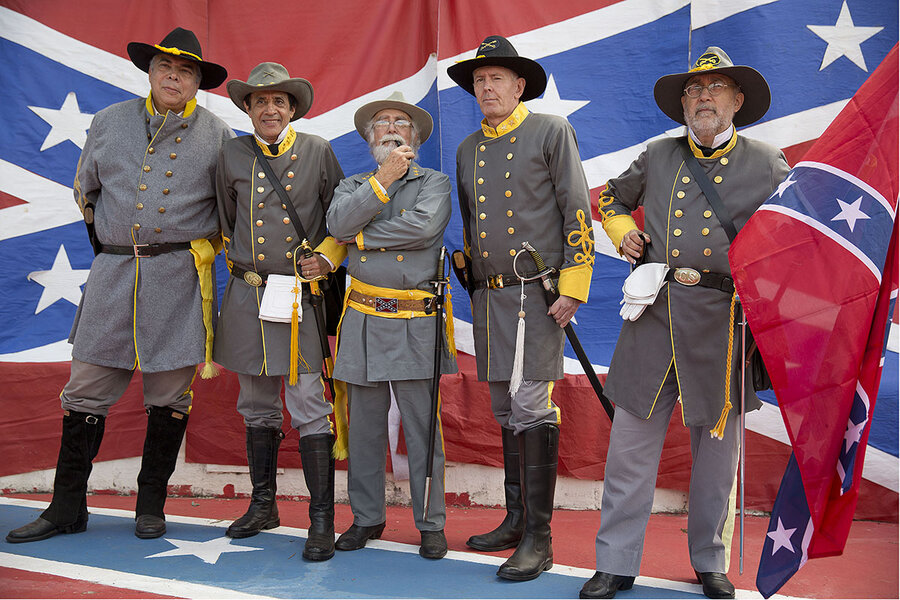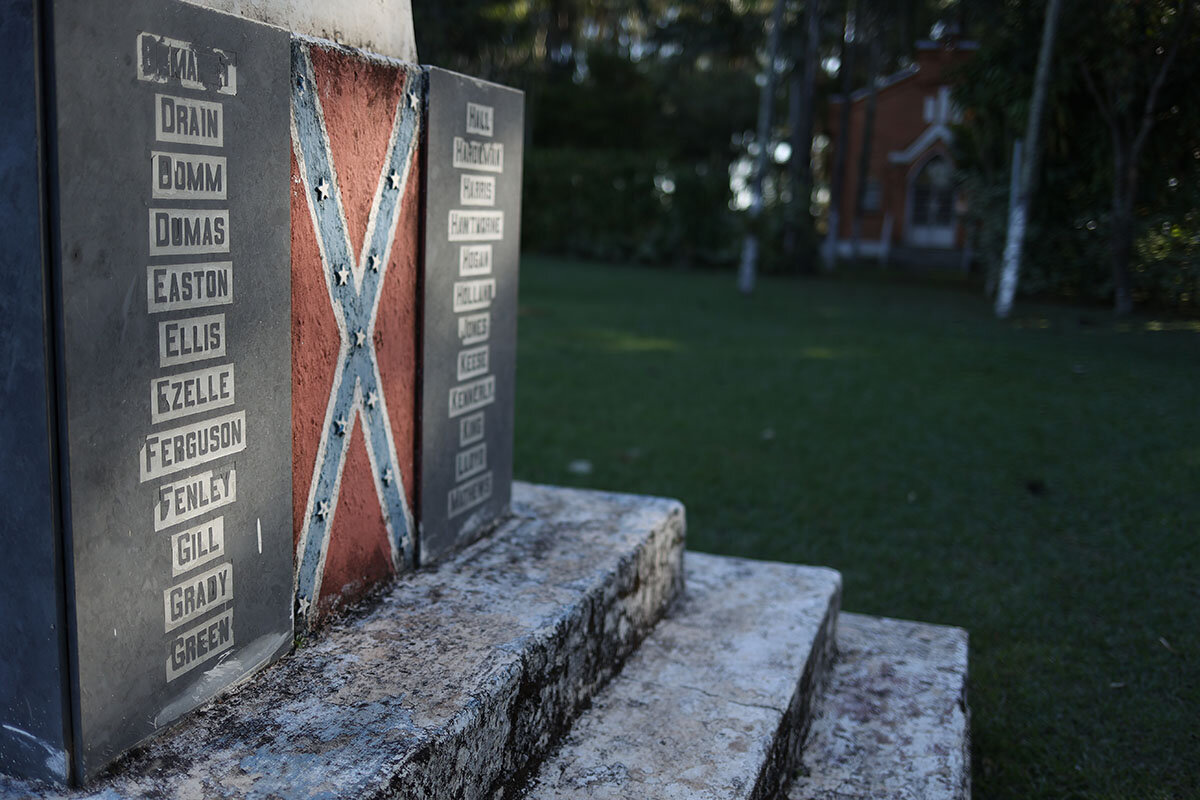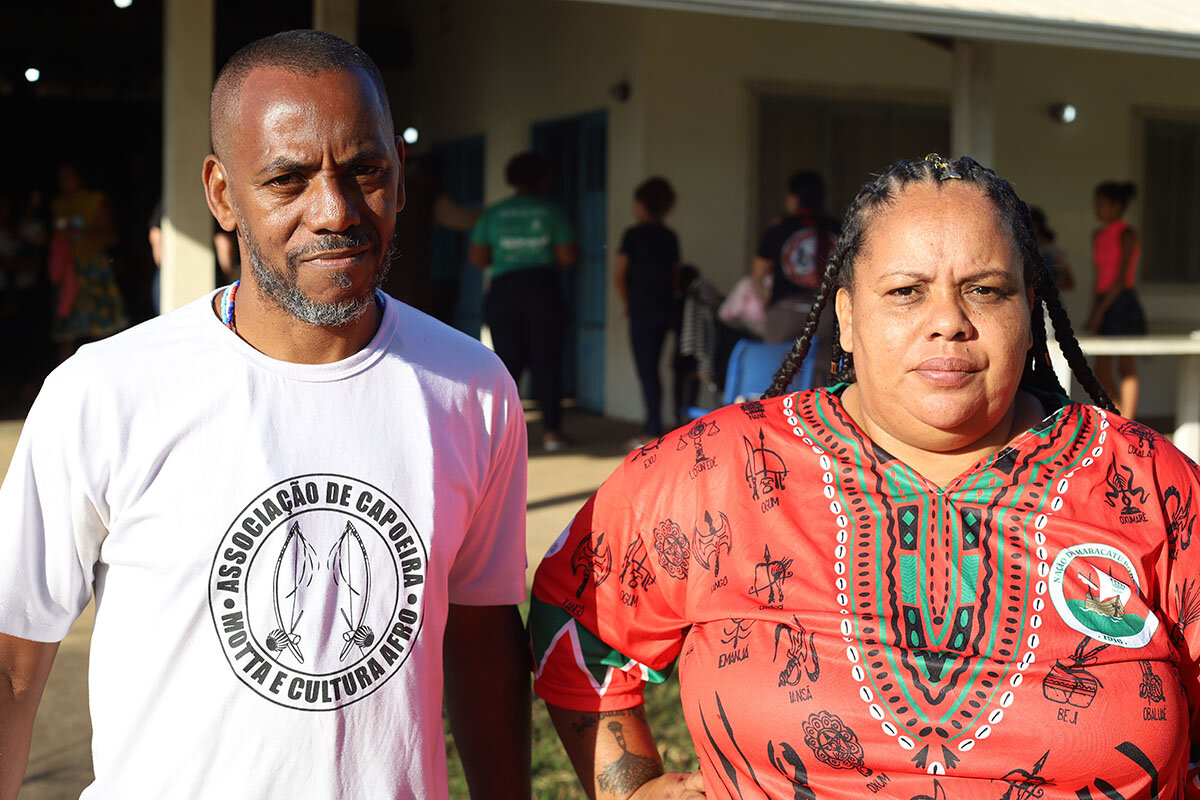New law could mark end of American Confederacy – in Brazil
Loading...
| SANTA BÁRBARA D’OESTE, Brazil
The Cemitério do Campo is unlike any other cemetery in Brazil. Located at the end of a dirt road in rural São Paulo state, it’s the site of an estimated 500 graves, a small ecumenical chapel – and one of the world’s largest Confederate flags.
Settled by Confederates fleeing their loss in the U.S. Civil War more than 150 years ago, it’s been host to the Festa Confederada, or Confederate Festival, for the past four decades. Thousands travel from across Brazil to celebrate the legacy of the Confederate States of America, complete with flags and a country music soundtrack. Attendees use “Confederate dollars” to buy chicken and biscuits, while watching reenactments from the antebellum South.
But a new municipal law could mean the end of the annual celebration and any other public event commemorating the Confederacy. The ordinance bans the use of racist symbols at public festivals, and the Confederate flag and this festival in Santa Bárbara d’Oeste are specifically named in the justification for the law, which passed last month with near-unanimous support.
The conflict here mirrors the ongoing debate over Confederate symbols and monuments in the United States, despite taking place thousands of miles south of the Mason-Dixon Line. For residents, however, it’s a hyperlocal dispute about representation and balancing the legacy of slavery in Brazil with the unusual story of American immigrants who settled in this small town a century and a half ago.
The law’s passage has raised the stakes on how this unique history should best be honored. While some are doubling down on the importance of the Confederate flag, others are using the ordinance as an opportunity to give new voice to often-overlooked narratives in Santa Bárbara d’Oeste. How the city identifies a middle ground between remembering the past and recognizing the weight of historic symbols could serve as a road map for other hot-button issues vexing an increasingly polarized Brazil in the future.
“This is an attempt … to reconsider history,” says Sidney Aguilar Filho, a historian and researcher at the University of Campinas, referring to the new law. He says it’s important to revisit and question the past. “The great value of this debate,” he says, is that it could help the community “face sadness and trauma with intellectual and historical honesty, so that we can move forward in our own story.”
Remembering history?
In 1866, Confederados, as they are called in Portuguese, fled defeat in the U.S. and started settling here, lured by offers of cheap land and labor. They collectively purchased more than 500 enslaved people, according to researchers from the Federal University of Tocantins. Some two decades later, Brazil became the last country in the Americas to abolish slavery. The region encompassing Santa Bárbara was the last to enforce the abolition.
“For us, the Confederate flag carries the symbolism of … resistance to tyranny,” not the symbolism of slavery, says João Padoveze, president of the Fraternidade Descendência Americana, or FDA, a group founded by the descendants of Confederate families. Leaders of the FDA are the chief opponents of the new law.
There’s a “lack of ability to distinguish between what is Confederate and what is United States” among residents who pass down misinformation about the Civil War, says American geographer Jordan Brasher, who wrote his doctoral dissertation on the Confederados.
In Santa Bárbara and the neighboring city of Americana, which was founded by Confederates, the FDA has controlled the historical narrative for years, romanticizing their ancestors and minimizing slavery, says Dr. Aguilar Filho.
“There has been a type of exaltation of this American immigration and an insistence on a vision that they were not Confederates in the strict sense of the word, that they were not enslavers,” says Dr. Aguilar Filho. “But documents and indexes don’t back this up.”
Growing up, Cláudia Monteiro da Rocha Ramos, a historian and activist, never paid much attention to the Confederate flags flying in her hometown. But that all changed for Ms. Monteiro, who is Black, after the 2017 Unite the Right rally in Charlottesville, Virginia.
“After Charlottesville, [the U.S.] debate about the flag resonated in Brazil,” says Ms. Monteiro, a leader of the local chapter of Unegro, a national anti-racism organization. “We organized several events and invited the FDA to participate. Our intention was to have dialogue and suggest they take down the Confederate flag and just fly the current American flag instead.”
On Sept. 30, 2017, Ms. Monteiro and Mr. Padoveze met for a public debate about Santa Bárbara’s Confederate iconography. It was the first time that the “benign” image of the Confederate flag was challenged here. Community members packed into a conference hall for the debate.
“It’s difficult for us to feel bad about something we’re proud of,” says Mr. Padoveze, a self-proclaimed redneck, using a term adopted from the U.S. He also has a Confederate flag on his belt buckle, keychain, wallet, lanyard, and Facebook cover photo, as well as on the bumper of his Ford truck.
“It’s a symbol of connection with our roots,” he says, adding that his ancestors were among the first Confederates to arrive in Brazil.
In April 2019, some 3,000 people attended the Festa Confederada – the last one held due to COVID-19 cancellations – where they watched a dance choreographed to the song “The Yellow Rose of Texas,” and a presentation of historical Confederate flags. Outside the grounds, a few dozen protesters gathered on the dirt road to perform traditional Afro-Brazilian dances, songs, and martial arts.
Atanael Motta Jr., a local organizer and capoeira teacher, says the protest was greeted with a mix of ambivalence and hostility.
FDA leaders “received us well,” he says. “But the people that were arriving to the festival waved flags at us to provoke us.”
According to the 2010 census, the most recent, Santa Bárbara is a majority-white city, with just shy of 30% Black and multiracial residents. Ms. Monteiro and others contest the accuracy of those numbers, estimating Black and multiracial residents make up closer to 60% of the population today.
Black community members say the enslavement of their ancestors has long been overshadowed by the story of the enslavers. Mr. Motta, along with his wife, Silvia, opened a cultural center in Americana this year to try and combat that legacy.
“We are resistance,” says Mr. Motta.
“Not against” celebrating ancestors
The Festa Confederada is one of the largest tourist attractions in Santa Bárbara, but it hasn’t always depended on Confederate symbols to draw tourists, says Dr. Brasher. At points over the past 40 years, it’s been a rock festival and a country festival, always leaning into exported stereotypes of U.S. Southern culture.
“We are not against people celebrating their ancestors,” says City Councilwoman Esther Moraes, who wrote and sponsored the law and insists the festival can continue celebrating American heritage. “The issue is the use of Confederate symbols … that represent the oppression that our Black population doesn’t want to carry any longer.”
The FDA is not united in its support for the flag.
“Look to the United States today, and you’ll see how poorly viewed the [Confederate] flag is,” says Jefferson Lafaiette Keese, who advocates for the use of the U.S. flag and plans to be buried with his Confederate ancestors in the Cemitério do Campo.
Mr. Keese calls flying the Confederate flag “an embarrassment.”
Confederate descendant Helena Bittencourt Pfaffenbach remembers a time when the Festa Confederada was more like a family reunion, and wishes the FDA would distance itself from the flag. She’s attended the festival just once over the past 20 years, when her son showed an interest, but says she found it “very commercial.”
“I don’t understand why we have to throw a party to celebrate the Confederate states,” says Ms. Pfaffenbach. “I think we can just celebrate our ancestors, and that’s it.”
Both Mr. Keese and Ms. Pfaffenbach pay the FDA to maintain their families’ gravesites. They still enjoy fond memories of the cemetery: For most of the year, it is a tranquil place. Sunlight pours through the North American pines, while green parrots fly and screech overhead.
“For us, [the law] is an advance,” says Ms. Motta, who opened the nearby Afro-Brazilian cultural center. But “it’s a regression for us to keep talking about American culture instead of Black culture.
“That’s the weight of this flag.”








